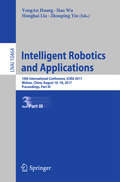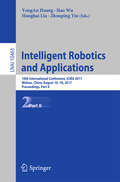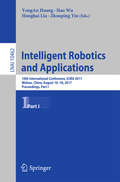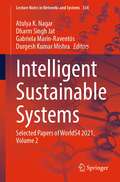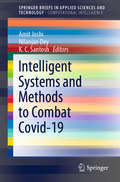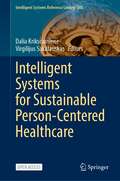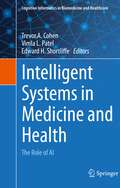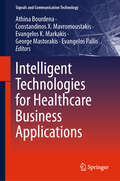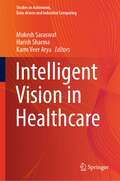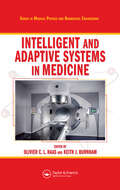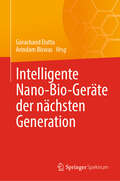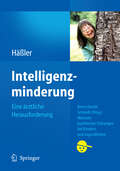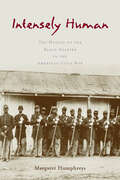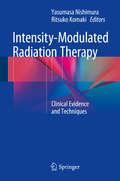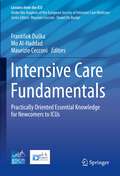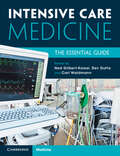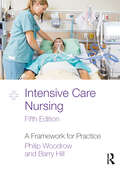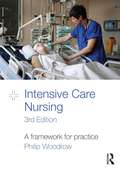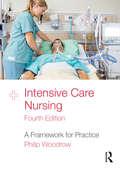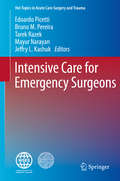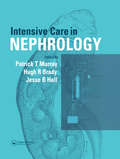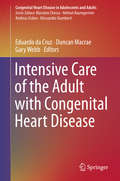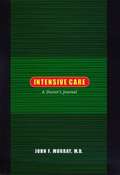- Table View
- List View
Intelligent Robotics and Applications
by Honghai Liu Hao Wu Zhouping Yin Yongan HuangThese two volumes constitute the refereed proceedings of the First International Conference on Intelligent Robotics and Applications, ICIRA 2008, held in Wuhan, China, in October 2008. The 265 revised full papers presented were thoroughly reviewed and selected from 552 submissions; they are devoted but not limited to robot motion planning and manipulation; robot control; cognitive robotics; rehabilitation robotics; health care and artificial limb; robot learning; robot vision; human-machine interaction & coordination; mobile robotics; micro/nano mechanical systems; manufacturing automation; multi-axis surface machining; realworld applications.
Intelligent Robotics and Applications
by Honghai Liu Hao Wu Zhouping Yin Yongan HuangThese two volumes constitute the refereed proceedings of the First International Conference on Intelligent Robotics and Applications, ICIRA 2008, held in Wuhan, China, in October 2008. The 265 revised full papers presented were thoroughly reviewed and selected from 552 submissions; they are devoted but not limited to robot motion planning and manipulation; robot control; cognitive robotics; rehabilitation robotics; health care and artificial limb; robot learning; robot vision; human-machine interaction & coordination; mobile robotics; micro/nano mechanical systems; manufacturing automation; multi-axis surface machining; realworld applications.
Intelligent Robotics and Applications: 10th International Conference, Icira 2017, Wuhan, China, August 16-18, 2017. Proceedings, Part I (Lecture Notes in Computer Science #10462)
by Honghai Liu Hao Wu Zhouping Yin Yongan HuangThese two volumes constitute the refereed proceedings of the First International Conference on Intelligent Robotics and Applications, ICIRA 2008, held in Wuhan, China, in October 2008. The 265 revised full papers presented were thoroughly reviewed and selected from 552 submissions; they are devoted but not limited to robot motion planning and manipulation; robot control; cognitive robotics; rehabilitation robotics; health care and artificial limb; robot learning; robot vision; human-machine interaction & coordination; mobile robotics; micro/nano mechanical systems; manufacturing automation; multi-axis surface machining; realworld applications.
Intelligent Sustainable Systems: Selected Papers of WorldS4 2021, Volume 2 (Lecture Notes in Networks and Systems #334)
by Durgesh Kumar Mishra Atulya K. Nagar Dharm Singh Jat Gabriela Marín-RaventósThis book provides insights of World Conference on Smart Trends in Systems, Security and Sustainability (WS4 2021) which is divided into different sections such as Smart IT Infrastructure for Sustainable Society; Smart Management prospective for Sustainable Society; Smart Secure Systems for Next Generation Technologies; Smart Trends for Computational Graphics and Image Modeling; and Smart Trends for Biomedical and Health Informatics. The proceedings is presented in two volumes. The book is helpful for active researchers and practitioners in the field.
Intelligent Systems and Methods to Combat Covid-19 (SpringerBriefs in Applied Sciences and Technology)
by Nilanjan Dey Amit Joshi K. C. SantoshThis book discusses intelligent systems and methods to prevent further spread of COVID-19, including artificial intelligence, machine learning, computer vision, signal processing, pattern recognition, and robotics. It not only explores detection/screening of COVID-19 positive cases using one type of data, such as radiological imaging data, but also examines how data analytics-based tools can help predict/project future pandemics. In addition, it highlights various challenges and opportunities, like social distancing, and addresses issues such as data collection, privacy, and security, which affect the robustness of AI-driven tools. Also investigating data-analytics-based tools for projections using time series data, pattern analysis tools for unusual pattern discovery (anomaly detection) in image data, as well as AI-enabled robotics and its possible uses, the book will appeal to a broad readership, including academics, researchers and industry professionals.
Intelligent Systems for Sustainable Person-Centered Healthcare (Intelligent Systems Reference Library #205)
by Dalia Kriksciuniene Virgilijus SakalauskasThis open access book establishes a dialog among the medical and intelligent system domains for igniting transition toward a sustainable and cost-effective healthcare. The Person-Centered Care (PCC) positions a person in the center of a healthcare system, instead of defining a patient as a set of diagnoses and treatment episodes. The PCC-based conceptual background triggers enhanced application of Artificial Intelligence, as it dissolves the limits of processing traditional medical data records, clinical tests and surveys. Enhanced knowledge for diagnosing, treatment and rehabilitation is captured and utilized by inclusion of data sources characterizing personal lifestyle, and health literacy, and it involves insights derived from smart ambience and wearables data, community networks, and the caregivers’ feedback. The book discusses intelligent systems and their applications for healthcare data analysis, decision making and process design tasks. The measurement systems and efficiency evaluation models analyze ability of intelligent healthcare system to monitor person health and improving quality of life.
Intelligent Systems in Medicine and Health: The Role of AI (Cognitive Informatics in Biomedicine and Healthcare)
by Vimla L. Patel Edward H. Shortliffe Trevor A. CohenThis textbook comprehensively covers the latest state-of-the-art methods and applications of artificial intelligence (AI) in medicine, placing these developments into a historical context. Factors that assist or hinder a particular technique to improve patient care from a cognitive informatics perspective are identified and relevant methods and clinical applications in areas including translational bioinformatics and precision medicine are discussed. This approach enables the reader to attain an accurate understanding of the strengths and limitations of these emerging technologies and how they relate to the approaches and systems that preceded them. With topics covered including knowledge-based systems, clinical cognition, machine learning and natural language processing, Intelligent Systems in Medicine and Health: The Role of AI details a range of the latest AI tools and technologies within medicine. Suggested additional readings and review questions reinforce the key points covered and ensure readers can further develop their knowledge. This makes it an indispensable resource for all those seeking up-to-date information on the topic of AI in medicine, and one that provides a sound basis for the development of graduate and undergraduate course materials.
Intelligent Technologies for Healthcare Business Applications (Signals and Communication Technology)
by Constandinos X. Mavromoustakis George Mastorakis Evangelos Pallis Evangelos K. Markakis Athina BourdenaThis book covers a wide range of applications and scenarios of intelligent technologies for healthcare business applications. The authors adopt an interdisciplinary approach with both theoretical and practical approaches in order to be relevant to multiple audiences. This book encapsulates fundamental and cutting-edge research paradigms of intelligent healthcare environments and addresses related open-ended research issues. The authors also explore recent advances, disseminate state-of-the-art techniques, and deploy novel technologies in intelligent healthcare services and applications. The book features a broad appeal to electrical, electronic, computer, software and telecommunications engineers in the healthcare space. Covers a range of applications and scenarios of intelligent technologies for healthcare business applications Explores advances, disseminates techniques, and deploys novel technologies in intelligent healthcare services Features paradigms of intelligent healthcare environments and addresses open-ended research issues
Intelligent Vision in Healthcare (Studies in Autonomic, Data-driven and Industrial Computing)
by Karm Veer Arya Harish Sharma Mukesh SaraswatThis book focuses on various aspects of computer vision applications in the field of healthcare. It covers new tools and technologies in some of the important areas of medical science like histopathological image analysis, cancer taxonomy, use of deep learning architecture dental care, and many more. Furthermore, this book reviews and discusses the use of intelligent learning-based algorithms for increasing the precision in medical domain. The book discusses different computer vision algorithms which are useful in various industries and day-to-day life. It also highlights many challenges faced by research community, like view point variations, scale variations, illumination variations, multi-modalities, and noise.
Intelligent and Adaptive Systems in Medicine (Series in Medical Physics and Biomedical Engineering)
by Olivier C. L. Haas Keith J. BurnhamIntelligent and adaptive techniques are rapidly being used in all stages of medical treatment, from the initial diagnosis to planning delivery and follow-up therapy.To realize the full potential of these techniques, developers and end users must understand both the underlying technology and the specifics of the medical application considered. Focus
Intelligente Nano-Bio-Geräte der nächsten Generation
by Arindam Biswas Gorachand DuttaDieses Buch befasst sich mit den Herausforderungen bei der Entwicklung einer Point-of-Care-Testplattform. Das Buch beschreibt Assays auf Basis gedruckter Chips (Lab-on-a-Chip, Lab-on-a-PCB) für den schnellen, kostengünstigen Nachweis von Biomarkern in realen Proben. Die größten Herausforderungen bei Point-of-Care-Tests sind die Implementierung komplexer Analysemethoden in kostengünstige Technologien. Dies gilt insbesondere für Länder mit einer weniger entwickelten Gesundheitsinfrastruktur. Waschfreie, Lab-on-Chip- und Lab-on-PCB-Techniken sind sehr einfach und innovativ für die Entwicklung von Point-of-Care-Geräten. Mit der Redox-Cycling-Technologie können mehrere interessante Targets gleichzeitig auf einem gedruckten Chip nachgewiesen werden. Die vorgeschlagenen Bereiche sind von Natur aus disziplinübergreifend und vereinen Fachwissen aus den Bereichen Biosensorik, Elektrochemie, Elektronik und Elektrotechnik, Gesundheitswesen und Fertigung. Dieses Buch befasst sich mit den jüngsten Fortschritten und verschiedenen Forschungsfragen im Bereich der Nanobiotechnologie-gestützten Biosensorik und sucht nach theoretischen, methodischen, etablierten und validierten empirischen Arbeiten, die sich mit diesen verschiedenen Themen befassen.
Intelligenzminderung
by Frank HäßlerDie Kenntnis der verschiedenen Ausprägungsarten von geistiger Behinderung und Minderbegabung ist entscheidend für Diagnose und Therapie. Früh beginnende Fördermaßnahmen sind notwendig, damit Kinder die Fähigkeiten und Fertigkeiten erlernen, die ihnen eine Teilhabe am sozialen Leben ermöglichen. Bei der Reihe "Manuale psychischer Störungen bei Kindern und Jugendlichen" steht der Patient im Mittelpunkt. Die Bücher bieten Betroffenen Tipps und Tricks zur Bewältigung des Alltags, Therapeuten erhalten wissenschaftlich fundierte Informationen.
Intensely Human: The Health of the Black Soldier in the American Civil War
by Margaret HumphreysBlack soldiers in the American Civil War were far more likely to die of disease than were white soldiers. In Intensely Human, historian Margaret Humphreys explores why this uneven mortality occurred and how it was interpreted at the time. In doing so, she uncovers the perspectives of mid-nineteenth-century physicians and others who were eager to implicate the so-called innate inferiority of the black body. In the archival collections of the U.S. Sanitary Commission, Humphreys found evidence that the high death rate among black soldiers resulted from malnourishment, inadequate shelter and clothing, inferior medical attention, and assignments to hazardous environments. While some observant physicians of the day attributed the black soldiers' high mortality rate to these circumstances, few medical professionals—on either side of the conflict—were prepared to challenge the "biological evidence" of white superiority. Humphreys shows how, despite sympathetic and responsible physicians' efforts to expose the truth, the stereotype of black biological inferiority prevailed during the war and after.
Intensely Human: The Health of the Black Soldier in the American Civil War
by Margaret HumphreysThis “informative” look at the causes of high mortality rates among black Civil War soldiers “gives readers some insight into current health disparities” (JAMA).Black soldiers in the American Civil War were far more likely to die of disease than were white soldiers. In Intensely Human, historian Margaret Humphreys explores why this uneven mortality occurred and how it was interpreted at the time. In doing so, she uncovers the perspectives of mid-nineteenth-century physicians and others who were eager to implicate the so-called innate inferiority of the black body.In the archival collections of the U.S. Sanitary Commission, Humphreys found evidence that the high death rate among black soldiers resulted from malnourishment, inadequate shelter and clothing, inferior medical attention, and assignments to hazardous environments.While some observant physicians of the day attributed the black soldiers’ high mortality rate to these circumstances, few medical professionals—on either side of the conflict—were prepared to challenge the “biological evidence” of white superiority. Humphreys shows how, despite sympathetic and responsible physicians’ efforts to expose the truth, the stereotype of black biological inferiority prevailed during the war and after.
Intensity-Modulated Radiation Therapy
by Yasumasa Nishimura Ritsuko KomakiSuccessful clinical use of intensity-modulated radiation therapy (IMRT) represents a significant advance in radiation oncology. Because IMRT can deliver high-dose radiation to a target with a reduced dose to the surrounding organs, it can improve the local control rate and reduce toxicities associated with radiation therapy. Since IMRT began being used in the mid-1990s, a large volume of clinical evidence of the advantages of IMRT has been collected. However, treatment planning and quality assurance (QA) of IMRT are complicated and difficult for the clinician and the medical physicist. This book, by authors renowned for their expertise in their fields, provides cumulative clinical evidence and appropriate techniques for IMRT for the clinician and the physicist. Part I deals with the foundations and techniques, history, principles, QA, treatment planning, radiobiology and related aspects of IMRT. Part II covers clinical applications with several case studies, describing contouring and dose distribution with clinical results along with descriptions of indications and a review of clinical evidence for each tumor site. The information presented in this book serves as a valuable resource for the practicing clinician and physicist.
Intensity-Modulated Radiation Therapy (Series in Medical Physics and Biomedical Engineering)
by S. WebbClinical conformal radiotherapy is the holy grail of radiation treatment and is now becoming a reality through the combined efforts of physical scientists and engineers, who have improved the physical basis of radiotherapy, and the interest and concern of imaginative radiotherapists and radiographers. Intensity-Modulated Radiation Therapy de
Intensive Care Fundamentals: Practically Oriented Essential Knowledge for Newcomers to ICUs (Lessons from the ICU)
by František Duška Mo Al-Haddad Maurizio CecconiThis book, part of the European Society of Intensive Care Medicine (ESICM) textbook series, is a graphical, dense and concise text describing fundamental theoretical concepts needed for doctors and other professionals new to the field of Intensive Care Medicine. The book serves two main purposes: as study material for any junior doctor, nurse or other allied healthcare professional who is time-pressured and wants to quickly learn the essentials; and as a course volume of new ESICM educational initiative called Intensive Care Fundamentals©. The overarching goal of this initiative is to offer standardised high-quality introductory education to all starters in intensive care. There are two key elements of this initiative: the book, which is the prerequisite reading for attending the two day face-to-face course and the materials, registration of candidate and training and certifying the trainers that will be provided by ESICM.
Intensive Care Medicine: The Essential Guide
by Edward Gilbert-Kawai Carl Waldmann Debashish DuttaExams are an essential component of one's training pathway in the quest to become a Consultant. For trainees undertaking a career in Intensive Care Medicine (ICM), sadly this is no exception, however, herewith is a suitable text to aid you upon that arduous journey towards the completion of your training – hurrah! Written in an accessible style, chapters follow a consistent layout throughout, including numerous images and tables, key learning points, and further reading. Experts in all of the main specialties provide specific and detailed knowledge of individual subject areas considered to be fundamental to one's ICM knowledge base. The authors cover a broad spectrum of topics including therapeutic interventions and organ support, paediatric care, comfort and recovery, psychiatric disorders, and end of life care. An essential preparation textbook and revision aid for exam candidates in Intensive Care Medicine, the book is a useful guide for mentors and trainees too.
Intensive Care Nursing: A Framework for Practice
by Philip Woodrow Barry HillThe fifth edition of this essential text provides a comprehensive overview of working in intensive care. Written for critical care nurses practising at Level 3, it is fully updated to ensure the evidence base is up to date and the content reflects contemporary best practice.Intensive Care Nursing covers patient-focused issues of bedside nursing; the technical knowledge necessary to care safely for ICU patients; the more common and specialised disease processes and treatments encountered; and how nurses can use their knowledge and skills to develop their own and others' practice. This feature includes all-new chapters on maternal critical care and principles of pharmacology for intensive care nursing. The chapters include numerous pedagogical features to aid readers in transferring their learning, such as boxes highlighting implications for practice, further reading sections, and clinical scenarios with questions.Intensive Care Nursing is essential reading for student and qualified nurses and allied health professionals working with critically ill patients, particularly those undertaking post-registration training in the area.
Intensive Care Nursing: A Framework for Practice
by Philip WoodrowThis new edition of Woodrow's Intensive Care Nursing will be warmly welcomed. Especially written for qualified nurses working in intensive care nursing units, this comprehensive text has been developed to be as accessible as possible. Including new chapters on planning for pandemics and transferring patients, it has been revised throughout to ensure the evidence-base is completely up-to-date and the content reflects contemporary best practice. Intensive Care Nursing is structured in user-friendly sections. Each chapter contains 'fundamental knowledge' needed to understand the chapter, an introduction, 'implications for practice', a chapter summary, completely updated further reading, 'time out' sections for revision and a clinical scenario with questions included. Reviewed throughout by experienced practitioners and teachers, it covers: patient-focused issues of bedside nursing the technical knowledge necessary to care safely for ICU patients the more common and specialized disease processes and treatments encountered how nurses can use their knowledge and skills to develop their own and others' practice. Written by a practice development nurse with a strong clinical background in intensive care nursing and experience of teaching nursing, Intensive Care Nursing is essential reading for nurses and health professionals working with high dependency patients, particularly those undertaking further training in the area.
Intensive Care Nursing: A Framework for Practice
by Philip WoodrowEspecially written for qualified nurses working in intensive care units, this comprehensive text has been developed to be as accessible as possible. This fourth edition has been revised throughout to ensure the evidence base is completely up to date and the content reflects contemporary best practice. Intensive Care Nursing is structured in user-friendly sections. The chapters contain sections outlining the "fundamental knowledge" needed to understand key chapters, "implications for practice" boxes, further reading and resources overviews, "time out" sections for revision and clinical scenarios with questions included. Reviewed throughout by experienced practitioners and teachers, it covers: patient-focused issues of bedside nursing; the technical knowledge necessary to care safely for ICU patients; the more common and specialised disease processes and treatments encountered; how nurses can use their knowledge and skills to develop their own and others' practice. Written by a practice development nurse with a strong clinical background in intensive care nursing and experience of teaching nursing, Intensive Care Nursing is essential reading for nurses and health professionals working with seriously ill patients, particularly those undertaking post-registration training in the area.
Intensive Care for Emergency Surgeons (Hot Topics in Acute Care Surgery and Trauma)
by Edoardo Picetti Bruno M. Pereira Tarek Razek Mayur Narayan Jeffry L. KashukThis book provides the basis needed for a dialogue between intensivists and emergency surgeons regarding the management and monitoring of acute care surgery (ACS) patients who require Intensive Care Unit (ICU) admission. It puts forward a practical approach to the treatment of common emergencies in daily clinical practice, and shares essential information on the treatment and monitoring of hemodynamic, respiratory, metabolic and neurological problems related to acute surgical patients requiring ICU admission. Furthermore, it includes two chapters regarding diagnostic and interventional radiology (fundamentals in daily emergency clinical practice), and addresses important issues such as ethics, mass casualty care, and care in low-resource settings. As such, the book not only offers a valuable guide for all practicing surgeons and intensivists, but is also relevant for residents and fellows who are newcomers to ACS.
Intensive Care in Nephrology
by Patrick T Murray Hugh R Brady Jesse B HallThe field of intensive care in nephrology is a rapidly evolving one, with research starting to translate into clinical guidelines and standards.Encompassing core subjects in critical care and nephrology, as well as specific related consultative topics, this clearly presented text is organized into three sections focusing on:* up-to-date background
Intensive Care of the Adult with Congenital Heart Disease (Congenital Heart Disease in Adolescents and Adults)
by Gary Webb Eduardo Da Cruz Duncan Macrae<P><P>Dedicated to the critical management of acutely ill adults with congenital heart disease, this comprehensive book discusses the many challenges faced in the management of these patients, who require intensive inter- and trans-disciplinary care. It provides the first universal review of the practical management of patients with these complex conditions, who survive into adulthood with congenital cardiac malformations and are often affected by other morbidities. For this reason, it reflects a consistent interaction and collaboration between several disciplines: pediatric and adult cardiology, cardiac surgery, pediatric and adult cardiac intensive care, anesthesia, intensive care nursing, nutrition, psychology and many other specialties. It offers concise and pragmatic recommendations, and provides basic and advanced concepts that allow caregivers to anticipate, prevent and effectively treat such pathologies. The book also includes chapters focusing on cardiac-database and risk-factor assessment, organizational and operational topics, advanced mechanical circulatory assistance and pharmacology. <P><P> Whilst bringing together top international experts who are leading reference programs around the globe, this book is an indispensable teaching tool for clinicians and caregivers involved in the management of critically ill adults with congenital heart disease.
Intensive Care: A Doctor's Journal
by John F. MurrayA day-by-day, minute-by-minute account of life in the intensive care unit of a major inner-city hospital, San Francisco General. Murray (medicine, U. of California--San Francisco) escorts readers on his daily ward rounds, introducing them to the desperately ill patients and to the young physicians and medical students who accompany him. They should come away with an understanding of how such wards work on the scientific, mechanical, political, social, and emotional levels.
